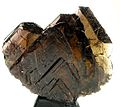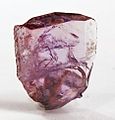Axinite
| Axinite | |
|---|---|
| Axinite from Piz Vallatscha , Canton of Graubünden , Switzerland (size: 4.0 × 3.8 × 3.2 cm) | |
| General and classification | |
| chemical formula | see single minerals |
|
Mineral class (and possibly department) |
Group silicates (sorosilicates) |
|
System no. to Strunz and to Dana |
9.BD.20 ( 8th edition : VIII / C.04) 56.02.02 |
| Similar minerals | Andalusite , barite , smoky quartz , titanite |
| Crystallographic Data | |
| Crystal system | triclinic |
| Crystal class ; symbol | triclinic pinacoidal; 1 |
| Space group | P 1 (No. 2) |
| Lattice parameters | see crystal structure |
| Formula units | Z = 2 |
| Frequent crystal faces | {111} {100} {201} {110} |
| Physical Properties | |
| Mohs hardness | 6 to 7 |
| Density (g / cm 3 ) | see single mineral |
| Cleavage | perfect {010} |
| Break ; Tenacity | shell-like |
| colour | yellow, yellow-orange, pale blue, gray, purple-brown, black |
| Line color | White |
| transparency | transparent to translucent |
| shine | glassy |
| Crystal optics | |
| Refractive indices |
n α = 1.672 to 1.693 n β = 1.677 to 1.701 n γ = 1.681 to 1.704 |
| Birefringence | δ = 0.009 to 0.011 |
| Optical character | biaxial negative |
| Axis angle | 2V = 69 to 87 ° (measured); 62 to 82 ° (calculated) |
| Pleochroism | strong, olive-green-red-brown-yellow-brown |
| Other properties | |
| Special features | red fluorescence at higher manganese contents |
Axinite (also Thumerstein or Thumit ) is the collective name for a group of unspecified minerals from the mineral class of " silicates and germanates ". These are the end links of a mixed crystal row with the following composition:
- Axinite- (Fe) (formerly ferro-axinite ): Ca 2 Fe 2+ Al 2 B [4] [O | OH | (Si 2 O 7 ) 2 ]
- Axinit- (Mg) ( Magnesio-Axinit ) Ca 2 MgAl 2 B [4] [O | OH | (Si 2 O 7 ) 2 ]
- Axinite- (Mn) ( manganese axinite ) Ca 2 Mn 2+ Al 2 B [4] [O | OH | (Si 2 O 7 ) 2 ]
As an intermediate element that counts Tinzenite having the composition (Ca, Mn 2+ ) 2 (Mn 2+ , Fe 2+ ) Al 2 B [O | OH | (Si 2 O 7 ) 2 ] to this mineral row.
Etymology and history
Axinite was first described by the French mineralogist René-Just Haüy in 1797, who named the mineral after its often characteristic, ax-like or hatchet-like crystal shape ( ancient Greek ἀξίνη axíne ).
classification
Already in the outdated 8th edition of the mineral classification according to Strunz , the minerals of the axinite group belonged to the class of "silicates and germanates" and there to the department "ring silicates (cyclosilicates)", where they together with baotite the "baotite-axinite group" with the System no. VIII / C.04 and the other members Kainosit , Muirit , Papagoit , Taramellit and Tinzenit .
In the Lapis mineral directory according to Stefan Weiß, which, out of consideration for private collectors and institutional collections, is still based on this classic system of Karl Hugo Strunz , the end members of the "Axinit Group" were given the system and mineral numbers VIII / C.08 -10 (Axinit- (Mg)), VIII / C.08-20 (Axinit- (Fe)) and VIII / C.08-30 (Axinit- (Mn)). In the “Lapis system”, this corresponds to the “Group silicates” department (as of 2018).
The 9th edition of Strunz's mineral systematics, which has been in effect since 2001 and was updated by the International Mineralogical Association (IMA) until 2009, also assigns the axinite group to the department of “group silicates (sorosilicates)”. However, this is further subdivided according to the structure of the silicate groups, so that the minerals sorted into the group according to their structure in the sub-section “Si 2 O 7 groups with additional anions ; Cations in tetrahedral [4] and / or other coordination ”can be found. The axinite group has the system no. 9.BD.20 .
The systematics of minerals according to Dana , which is mainly used in the English-speaking world , assigns the axinite group to the “group silicates” department. Here it is with the system no. 56.02.02 within the sub-section " Group silicates: Si 2 O 7 groups and O, OH, F and H 2 O with cations in [4] and / or> [4] coordination ".
Crystal structure
All minerals of the axinite group crystallize in triclinic space group P 1 (space group no. 2) , but differ in the respective due to the slightly different ionic radii of iron (82 pm ), magnesium (91 pm) and manganese (78 pm) Grid parameters :
- Axinite- (Fe): a = 7.16 Å ; b = 9.20 Å; c = 8.96 Å; α = 91.8 °; β = 98.1 ° and γ = 77.3 °
- Axinite- (Mg): a = 7.14 Å; b = 9.16 Å; c = 8.94 Å; α = 91.9 °; β = 98.1 ° and γ = 77.5 °
- Axinite- (Mn): a = 7.16 Å ; b = 9.18 Å; c = 8.96 Å; α = 92.0 °; β = 98.3 ° and γ = 77.3 °
The number of formula units per unit cell is two.
The axinite structure can be described as a sequence of borosilicate tetrahedral layers and layers of octahedral coordinated cations (Al, Fe, Ca, Mn, Mg).
Silicon (Si) and boron (B) are tetrahedrally surrounded by four oxygen ions (O). Each two SiO 4 - tetrahedra are on a common corner to a Si 2 O 7 connected group. Four such Si 2 O 7 groups are linked by two BO 4 tetrahedra via common corners to form a 6-membered borosilicate ring, from which two Si 2 O 7 groups branch off. These branched borosilicate anion complexes are arranged in layers parallel to the ( 1 2 1) plane.
Aluminum (Al), iron (Fe) and calcium (Ca) are octahedral surrounded by 6 oxygen atoms. Four AlO 6 - octahedra are connected by common edges to form a chain, each represents a FeO at their ends 6 sits octahedra. These linear 6-octahedron groups are connected to layers via strongly distorted CaO 6 octahedra.
properties
Some manganese-rich samples show red luminescence .
Education and Locations


Axinites are mainly formed through hydrothermal processes and contact metamorphosis in alpine fissures and calcareous rocks. As Begleitminerale occur among other actinolite , albite , Andradite , calcite , chlorite , Datolith , epidote , Hedenbergit , clinozoisite , prehnite , quartz , tremolite , tourmaline , Vesuvianit and Zoisit on.
In general, axinite occurs rather rarely, which means that it can be partly abundant at different sites, but overall it is not very common. The most widespread is Axinit- (Fe) with around 230 known sites, followed by Axinit- (Mn) with around 60 and Axinit- (Mg) with around 10 known sites (as of 2012).
In Germany, axinite (Fe) and axinite (Mn) have so far only occurred in the Harz (Bad Harzburg, Treseburg), with the resin being the type locality for the axinite (Mn) . It was also found earlier in the area around Thum in the Saxon Ore Mountains , which is where the name Thumerstein or Thumit comes from.
In Austria, Axinit- (Fe) was found in several places in Carinthia (Koralpe, Saualpe) and Salzburg (Hohe Tauern, Saalfelden), Axinit- (Mg), on the other hand, so far only near Schwallenbach in Lower Austria.
In Switzerland, Axinit- (Fe) could be detected at Steinibach ( Elm GL , Glarus) as well as in several locations in the cantons of Graubünden , Ticino , Uri and Valais .
Other locations include Australia, Chile, China, Finland, France, Iran, Ireland, Italy, Japan, Canada, Kazakhstan, Madagascar, Morocco, Mexico, Namibia, New Zealand, Norway, Pakistan, Peru, Poland, Romania, Russia, Sweden, Slovakia, Spain, South Africa, Tanzania, the Czech Republic, Turkey, Hungary, the United Kingdom (Great Britain) and the United States of America (USA).
Axinite- (Fe) from Le Bourg-d'Oisans , Isère, Rhône-Alpes, France (size: 8.7 × 5.7 × 4.0 cm)
Axinite- (Mn) from Dalnegorsk , Primorye Region, Russia (size: 4.1 × 4 × 3.8 cm)
Axinite- (Mn) from Vitória da Conquista , Bahia, Brazil (size: 5.5 × 2.4 × 0.8 cm)
use
Axinite is primarily a collector's mineral because of its often pronounced ax-shaped crystals. If the quality is good, it is occasionally made into gemstones .
See also
literature
- Hans Jürgen Rösler : Textbook of Mineralogy . 4th revised and expanded edition. German publishing house for basic industry (VEB), Leipzig 1979, ISBN 3-342-00288-3 , p. 549-550 .
- Helmut Schrätze, Karl-Ludwig Weiner: Mineralogy. A textbook on a systematic basis . de Gruyter, Berlin; New York 1981, ISBN 3-11-006823-0 , pp. 732-734 .
- John W. Anthony, Richard A. Bideaux, Kenneth W. Bladh, Monte C. Nichols: Ferroaxinite . In: Handbook of Mineralogy, Mineralogical Society of America . 2001 ( PDF 69.9 kB ).
- John W. Anthony, Richard A. Bideaux, Kenneth W. Bladh, Monte C. Nichols: Magnesioaxinite . In: Handbook of Mineralogy, Mineralogical Society of America . 2001 ( PDF 67.9 kB ).
- John W. Anthony, Richard A. Bideaux, Kenneth W. Bladh, Monte C. Nichols: Manganaxinites . In: Handbook of Mineralogy, Mineralogical Society of America . 2001 ( PDF 74.1 kB ).
- Chris Pellant: Stones and Minerals . 1st edition. Dorling Kindersley Limited, 1992, ISBN 978-3-8310-0892-6 , pp. 149 .
- Rudulf Duda, Lubos Rejl: Minerals Guide - Minerals, Rocks, Gems . Franckh-Kosmos, 2002, ISBN 978-3-440-08471-7 , pp. 185 .
- J. Filip, U. Kolitsch, M. Novak, O. Schneeweiss: The crystal structure of near-end-member ferroaxinite from an iron-contaminated pegmatite at Malesov, Czech Republic . In: The Canadian Mineralogist . 2006, pp. 1159–1170 ( PDF 356 kB )
Web links
- Mineral Atlas: Axinit
- realgems.org - Axinite (with picture examples of cut Axinite)
- Mindat - Axinite (English)
Individual evidence
- ↑ a b c Uni Terra, Kindler & Gliech GbR Germany, Berlin - table of ionic radii (excerpt)
- ↑ a b c d e f g h Hugo Strunz , Ernest H. Nickel: Strunz Mineralogical Tables . 9th edition. E. Schweizerbart'sche Verlagbuchhandlung (Nägele and Obermiller), Stuttgart 2001, ISBN 3-510-65188-X , p. 573-574 .
- ↑ a b c d Mindat - Axinit- (Fe)
- ↑ a b c d Mindat - Axinit- (Mg)
- ↑ a b c d Mindat - Axinit- (Mn)
- ↑ a b Stefan Weiß: The large Lapis mineral directory. All minerals from A - Z and their properties. Status 03/2018 . 7th, completely revised and supplemented edition. Weise, Munich 2018, ISBN 978-3-921656-83-9 .
- ^ Henry George Liddell, Robert Scott: An Intermediate Greek-English Lexicon at perseus.tufts.edu
- ↑ http://www.mindat.org
- ↑ Ernest H. Nickel, Monte C. Nichols: IMA / CNMNC List of Minerals 2009. (PDF 1703 kB) In: cnmnc.main.jp. IMA / CNMNC, January 2009, accessed October 25, 2019 .
- ↑ a b c Filip et al: The crystal structure of near-end-member ferroaxinite from an iron-contaminated pegmatite at Malesov, Czech Republic








